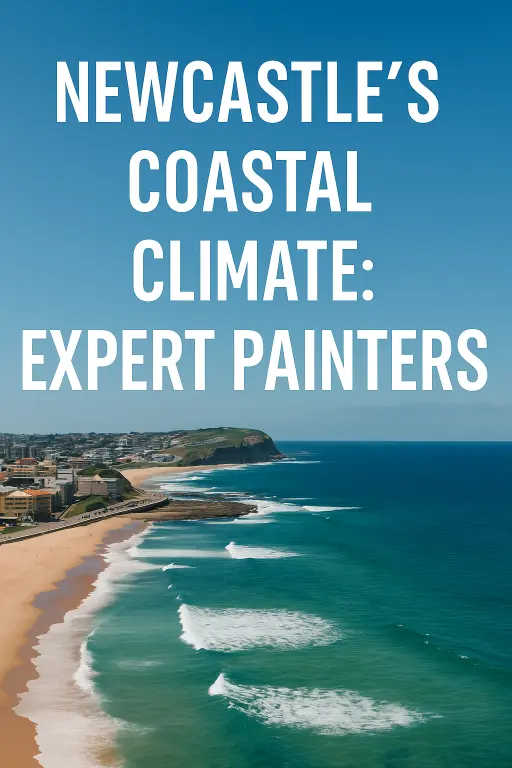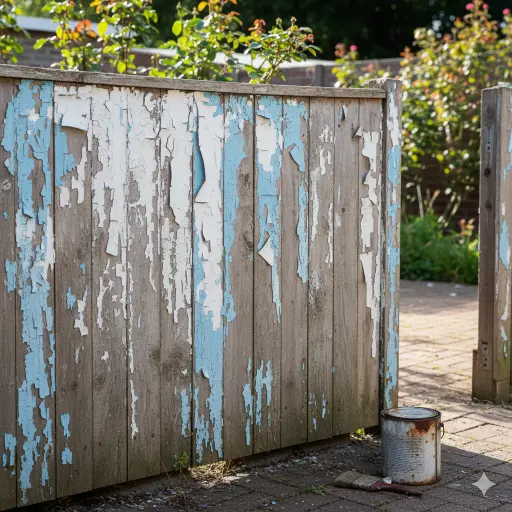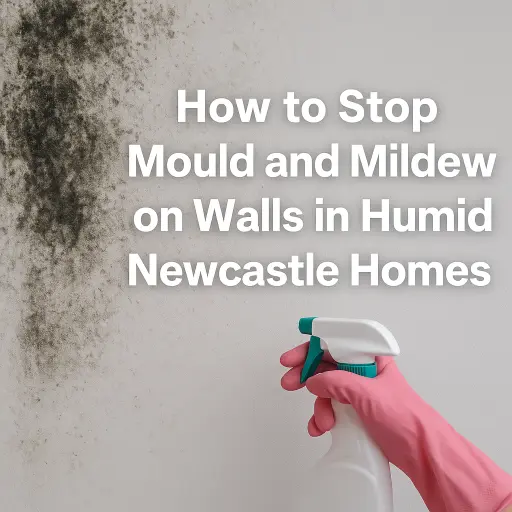Why Newcastle’s Coastal Climate Means You Need Expert Painters
Why This Guide is Different
If you live in Newcastle, you already know the view from your home is priceless — but the salty breeze and humid air come at a cost. Paint simply doesn’t last here like it does inland.
Most painting articles online give generic advice that works for dry climates, but not for C5 coastal corrosion zones like ours. That’s where experienced painters in Newcastle make the difference.
This guide blends local expertise — built from 14+ years of Procover Painting projects across Newcastle, Port Stephens, and Lake Macquarie — with trusted industry standards such as AS/NZS 2311 and ISO 12944 to give you:
- The real science of why coastal paint fails
- How far can salt damage reach
- Warning signs of paint failure specific to Newcastle
- Our proven step-by-step coastal painting process
- A homeowner maintenance plan tailored for our conditions
- Myths debunked by professional painters in Newcastle
- Colour and product recommendations for our climate
- A real-world case study showing what works
1 – Newcastle’s Coastal Climate: The Two Big Enemies of Paint
1. Salt in the Air
- Eats away at paint’s protective film
- Traps moisture against timber
- Accelerates rust on metals

2. High Humidity

2 – How Far Does Salt Travel in Newcastle?
C5 – Very High | 0–200 m | Extreme salt | Merewether beachfront, Nobbys, Stockton foreshore |
C4 – High | 200 m–1 km | Heavy salt | Bar Beach backstreets, Stockton inner streets |
C3 – Medium | 1–10 km | Moderate salt | Hamilton South, Adamstown, Mayfield East |
| 0–200 m | C5 | 3–5 years | 6–8 years |
| 200 m–1 km | C4 | 5–7 years | 8–10 years |
| 1–10 km | C3 | 7–10 years | 10–12 years |
3 – Four Clear Signs of Coastal Paint Damage
In Newcastle’s coastal climate, paint problems can appear quickly — sometimes in just a few seasons. Here’s what to look for before small issues turn into expensive repairs:
1. Blistering or Bubbling
- Small, raised bubbles or blisters appear on painted surfaces after humid or rainy weather.
- It occurs when moisture becomes trapped under the paint film, often due to painting over damp surfaces or salt contamination.
- If ignored, blisters will break open, exposing the surface to further damage.
What to do: Sand back the affected area, remove any salt, prime correctly, and recoat.
2. Peeling or Flaking
- Paint starts to lift and break away from the surface, leaving bare patches.
- Usually happens when the bond between paint and substrate fails — often from poor preparation, extreme weather, or salt build-up.
- Once exposed, timber can absorb water and metals can corrode rapidly.
What to do: Remove all loose paint, treat the substrate, and use a coating system suited for coastal exposure.
3. Fading Colours
- Australia’s UV index often reaches 11–14 in summer — one of the highest in the world.
- Dark colours fade faster, while lighter shades tend to chalk (form a powdery surface) and lose sheen.
- Fading isn’t just cosmetic — UV damage can also weaken the paint’s protective layer.
What to do: Choose UV-stable colours and finishes, and follow a maintenance schedule to refresh high-sun areas more often.
4. Rust Stains
- Brown or reddish streaks running down from gutters, screws, window frames, or other metal components.
- Even Colorbond® can be affected if scratched or if protective coatings are breached.
- Rust stains often indicate corrosion is already underway beneath the surface.
What to do: Address the source — treat and prime the rusting metal before recoating, and keep vulnerable areas rinsed free of salt.
4 – Hidden Damage Beneath the Surface
1. Wood Rot in Fascia, Cladding, and Windows
- Timber absorbs moisture like a sponge, especially through exposed end grain or hairline cracks.
- Over time, this leads to soft, crumbly wood that loses its structural strength.
- Fascia boards can sag, cladding can warp, and window frames can swell or jam.
- Rot can spread unseen beneath the paint before there’s any visible damage outside.
2. Mould Growth Inside the Walls
- Moisture trapped in wall cavities creates the perfect environment for mould.
- Mould spores spread quickly, damaging plasterboard, insulation, and even personal belongings.
- Inhaling mould spores can cause respiratory irritation, allergies, and other health issues.
- In many cases, mould from a small paint breach can mean removing entire sections of internal lining to fix the problem.
3. Corrosion in Fixings and Framing
- Metal screws, nails, brackets, and even structural steel components start to corrode when exposed to salt-laden moisture.
- Corrosion weakens the connection points holding your home together.
- In extreme cases, you might see rust bleeding through paint or staining nearby surfaces — that’s a sign the damage is already advanced.
A small patch of peeling paint can be the start of a chain reaction. What might cost a few hundred dollars to fix early can quickly escalate into a multi-thousand-dollar repair involving carpenters, plasterers, and metal fabricators..
We’ve seen $500 touch-up jobs turn into $5,000 timber replacement projects.
| Substrate | Common coastal problem | Fix that lasts | Notes |
|---|---|---|---|
| Masonry/render | Hairline cracks, chalking | Acrylic sealer + high-build membrane or premium exterior acrylic | Wash salts before any sanding. (Contentful Assets) |
| Timber | Tannin bleed, UV greying | Stain-blocking or oil-based primer + two premium topcoats | Keep end-grain sealed. |
| Mild steel | Flash rust, underfilm corrosion | Zinc-rich/epoxy primer + durable topcoat | Respect 3°C above dew point, ≤85% RH. (info.wattyl.com.au) |
| Aluminium | Poor adhesion | Proper etch/bonding primer + UV-stable topcoat | Degrease well; no shortcut priming. |
| Colorbond | Chalky, glossy surface | Clean, abrade if needed + bonding primer + acrylic topcoat | Avoid hot substrates >40°C. (Dulux) |
5 – The Procover Painting Coastal System
Our system is designed specifically for Newcastle’s coastal climate, where salt, humidity, and UV combine to wear down paint faster than in inland areas. Each step is done for a reason — to extend the life of your paint job and protect your home.
Step 1 – Detailed Inspection
Before we pick up a brush, we thoroughly check your home for:
- Rot in timber — soft fascia boards, cracked window sills, or damaged cladding.
- Rust on metal surfaces — even small rust spots can spread under new paint.
- Failed sealants — gaps around windows, doors, and joints that let moisture in.
Why it matters: Fixing these issues before painting stops hidden damage from undermining your new finish.
Step 2 – Salt Removal
We use a low-pressure rinse with fresh water and a neutral pH cleaner to strip away salt deposits from walls, trims, and eaves.
Why it matters: Salt attracts and holds moisture, even on dry days. If it’s trapped under paint, it can cause blistering, peeling, and rust.
Step 3 – Repairs & Sanding
- Replace damaged timber with suitable treated or hardwood replacements.
- Treat rust with corrosion inhibitors so it doesn’t bleed back through the new coating.
- Sand loose, flaking, or chalky paint back to a solid, stable base.
Why it matters: Paint sticks best to a clean, sound surface. Poor prep is the number one cause of premature paint failure.
Step 4 – Priming
We match the primer to the material:
- Masonry – High-build sealer to lock in the surface and fill micro-cracks.
- Timber – Penetrating oil-based primer brushed into the grain for deep protection.
- Metal – C4–C5 rated anti-corrosion primer for maximum salt resistance.
Why it matters: The right primer seals the surface, improves adhesion, and forms the first defence layer against moisture and salt.
Step 5 – Film Thickness Control
We use wet-film gauges during application to check that the paint coats meet the manufacturer’s required thickness.
Why it matters: Coastal protection depends on film build. Too thin and the coating fails early; too thick and it can crack.
Step 6 – UV-Resistant Topcoats
We finish with premium exterior paints from Dulux, Haymes, or Wattyl that:
- Include mould inhibitors to combat Newcastle’s humidity.
- Offer high flexibility to expand and contract with temperature changes.
- Deliver superior UV resistance to slow down fading and chalking.
Why it matters: Newcastle’s UV index can hit 11–14 in summer. Without UV resistance, colours fade and surfaces break down quickly.
Product Comparison for Newcastle Homes
| Brand & Product | UV Resistance | Mould Resistance | Flexibility | Best Use |
|---|---|---|---|---|
| Dulux Weathershield | ★★★★★ | ★★★★★ | ★★★★☆ | Walls, trims |
| Haymes Solashield | ★★★★★ | ★★★★☆ | ★★★★★ | Weatherboards, fascia |
| Wattyl Solagard | ★★★★☆ | ★★★★★ | ★★★★☆ | Masonry, fences |
Myths vs Facts
| Myth | Fact |
|---|---|
| “Two coats are always enough” | Film thickness matters more than coat count in coastal areas |
| “Winter is best for painting” | Winter humidity and dew can cause adhesion failure |
| “I’m 1 km from the beach, so salt won’t reach me” | Newcastle winds carry salt several kilometres inland |
6 – Maintenance That Saves You Money
A great paint job is an investment — and like any investment, it needs upkeep to protect its value. In Newcastle’s salty, humid conditions, even the best coatings last longer when they’re maintained. Skipping these steps can cut your paint’s life in half and lead to costly repairs.
Every 6 Months – Fresh-Water Rinse
- Use a garden hose (low to moderate pressure) to rinse walls, eaves, balustrades, and fences.
- Focus on areas sheltered from rain, like under eaves and around verandahs — these trap the most salt.
- Avoid high-pressure washers unless necessary, as they can force water behind cladding or damage softer surfaces.
Why it matters: Salt attracts and holds moisture, which accelerates rot, mould, and corrosion. Removing it regularly is one of the simplest ways to extend your paint’s life.
Every Spring – Inspect and Repair
- Look for cracks, chalking, mould, or rust stains.
- Check sunny faces for fading and shaded sides for mould growth.
- Treat small patches immediately — sand, spot prime, and repaint before summer’s heat or storms worsen the damage.
Why it matters: Fixing minor issues early can save thousands in future repairs, especially on timber and metalwork.
Every 3–5 Years – Touch Up High-Wear Areas
- Recoat sun-beaten walls, exposed fascias, and metal railings before the coating breaks down completely.
- Use the same product and colour to maintain consistency.
- For metals, ensure the surface is clean and rust-free before recoating.
Why it matters: High UV zones and exposed metals take the brunt of Newcastle’s weather. Touch-ups act like a booster shot, prolonging the full repaint cycle.
Full Repaints – Timing Guide
- Inland Newcastle: Every 7–10 years, depending on surface type, colour choice, and sun exposure.
- Coastal zones (C3–C5): Every 5–7 years, shorter in severe shorelines.
- Choose higher-performance systems in these zones — marine-grade primers, UV-stable topcoats, and flexible finishes.
Why it matters: Manufacturer care guides and industry experience confirm these timeframes. Coastal homeowners who use premium products and follow a maintenance plan often get 2–3 extra years before needing a repaint.
7 – Things Most People Miss (Small Details, Big Wins)
When it comes to painting in Newcastle’s coastal climate, small oversights can lead to big problems. These are details even some painters skip — but they can make a huge difference in how long your paint lasts.
1. Edges Fail First
- Sharp corners and edges are harder for paint to grip, and coatings naturally go on thinner there.
- Always round or ease sharp edges before painting to allow for an even, protective film build.
Why it matters: Thinner paint on edges is the first to break down, letting moisture and salt in.
2. Unwashed Areas Trap Salt
- Salt doesn’t just sit on visible walls. It collects in hidden spots like under eaves, behind downpipes, and under rail caps.
- Rinse these areas during regular maintenance — they’re often the source of hidden corrosion.
Why it matters: Salt in unwashed areas slowly migrates into surrounding paintwork, causing blistering and rust.
3. Gloss Isn’t Always Best Outside
- High-gloss finishes are easy to wash and resist dirt, but they highlight surface imperfections.
- Use a mix of sheens:
- Flat or low sheen for ceilings and walls in low-touch areas.
- Semi-gloss or gloss for trims, handrails, and wet areas.
Why it matters: Choosing the right sheen for each surface balances appearance, cleanability, and durability.
4. Colour Choice Affects Life
- Very dark colours absorb more heat, especially in Newcastle’s strong sun.
- Heat causes paint resins to expand, contract, and degrade faster.
Why it matters: Choosing lighter or mid-tone colours can extend the life of your paint job and reduce surface cracking.
5. Follow the TDS, Not Rumours
- The Technical Data Sheet (TDS) for each product is the manufacturer’s rulebook.
- Many specify no painting above 85% RH or within 3°C of the dew point.
- Check these limits for the exact paint you’re using — don’t rely on hearsay
8 – Case Study: Merewether Beach House
Background
This coastal home sits less than 200 metres from Merewether Beach — right in a C5 corrosion zone, where salt exposure is at its highest. Despite a repaint just three years earlier, the property was already showing major signs of coating failure.
Before We Started
- Peeling paint on sun-facing walls within 3 years of the last repaint.
- Rusting metal window frames where the previous coating had failed.
- Black mould growth on the shaded south wall.
- No clear maintenance plan from the previous painter allowed damage to accelerate.
Our Process
Step 1 – Salt Removal
- Low-pressure salt wash with fresh water and a neutral pH cleaner to break down salt deposits.
Step 2 – Rust Treatment
- Applied rust converter and corrosion-inhibiting primer to all affected metal frames.
Step 3 – Surface Priming
- Used a high-build primer to fill minor surface imperfections and seal the substrate.
Step 4 – Premium Topcoat Application
- Applied Dulux Weathershield semi-gloss with full wet-film thickness checks to meet manufacturer specifications for C5 environments.
The Result
- 5-year warranty finish — even in a severe C5 salt zone.
- Black mould eliminated, with a mould-inhibiting topcoat to slow regrowth.
- Corrosion halted on all treated metalwork.
- Client provided with a tailored maintenance schedule to preserve the finish for as long as possible.
Call Procover Painting
Need a long-lasting finish by painters in Newcastle who plan around dew point, salt, and wind — not guesswork?
Procover Painting has over 14 years of experience across Newcastle, Maitland, Port Stephens, Lake Macquarie, the Hunter Valley, and Cessnock.
We offer transparent pricing, quality materials, and a 5-year workmanship warranty.






